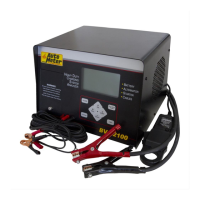44
n Incorrect Application: Wrong size battery may have inadequate cold
cranking rating for original vehicle specications.
n Incorrect Installation: Loose battery hold-downs cause excessive
vibration, which can result in damage to the plates.
n Improper Maintenance: Low electrolytic uid and corrosion on battery
connections can greatly reduce battery life and effect battery performance.
n Internal Connections: Make sure internal connections of entire charging
system meet proper specications.
n Age of Battery: If the date code on the battery is old, test failure may
indicate the need of replacement.
n Overcharging: Overcharging caused by a high voltage regulator setting
or incorrect battery charging can cause excessive gas, heat and water
loss.
n Undercharging: Undercharging caused by a faulty charging system or
low voltage regulator setting can cause lead sulfate to gradually build up
and crystallize on the plates, greatly reducing the battery’s capacity and
ability to be recharged.
n Cycling: Excessive drain on battery when alternator is not operating.
CAUSE OF BATTERY FAILURE
nCarefully read all operating instructions
before operating the BVA-2100
nWear eye protection when working on
batteries.
nBe sure each test is complete before
removing load clamps to prevent arcing
and potential explosion from battery gases.
Never remove load clamps while testing.
Keep sparks, ames or cigarettes away
from battery.
nKeep hair, hands, and clothing as well as
tester leads and cords away from moving
blades and belt.
nProvide adequate ventilation to remove
exhaust.
nIn extremely cold temperatures check for
frozen electrolyte uid or swelled case
before applying load. Do not attempt to
Load Test or charge a battery under 20
o
F.
(-7
o
C.). Allow the battery to warm to room
temperature before testing or charging.
n Warning! Never attach the BVA-2100 to
a battery connected to any other tester or
charging unit. Damage may result.
SAFETY
NOTES
4545

